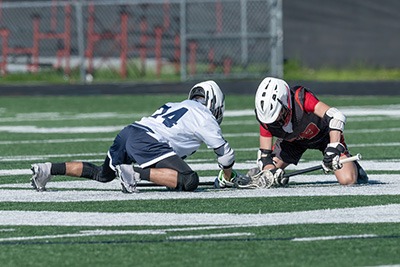Lacrosse is an action-packed sport that's fun for all ages and levels of experience. Knowing how lacrosse rules work and the lacrosse basic rules is key to getting the most out of this fast-paced game, whether you're a seasoned veteran or just starting.
This post will review some essential lacrosse rules and give 2023 players (including youth league teams) and lacrosse penalty tips for beginners.
So grab your gear and let's dig in: here are the basics each player needs to know about before suiting up.
More...
Take Away Key Points:
Basic Lacrosse Rules

Here are the basic rules of lacrosse:
1. The field of play is 110 yards long and 60 yards wide.
2. The team comprises ten players on the field—six attacks, three defenses, and one goalie.
3. All players must use a stick with a netted pocket to move the ball around the field and score goals.
4. The game begins with a face-off at midfield by two opposing players who stand opposite each opposing player with their sticks held up in the air until the official blows the whistle to start play.
5. A goal is scored when the ball crosses through a goal guarded by a goalie and not touched by another player before entering the goal area.
6. Players can run with their lacrosse sticks in possession of the ball and pass, catch and shoot during play; however, no running with the ball or body contact is allowed.
7. The team scoring more goals wins the game; however, if scores are tied after regulation time, an overtime period will be played until one team breaks away from the tiebreaker and scores first to win the game!
How is Lacrosse Played?
Boys lacrosse is a dynamic and fast-paced game combining hockey and basketball elements.
The crease is a circular area around the goal that players from the defending team must stay out of to prevent unnecessary contact with the goalie. The crease rules in lacrosse state that no player other than the goaltender can enter or remain in the crease at any time.
Lacrosse begins with the two teams facing each other in their respective positions on the field. Then, the attack line of one team will attempt to move the ball into the attack area of the other team by passing it between players or carrying it across field boundaries. This is known as a face-off.
When a goal is scored, play resumes with another faceoff at the center of the field and continues until time runs out or either team calls a timeout. At the end of regulation time, if there is still no clear winner, an overtime period is added to decide who wins the game. The overtime period typically lasts two minutes and can result in a draw or a win, depending on which team scores more goals within this time limit.
Players use a long-handled stick with a head of loose netted strings. To move the ball, players must catch it in their lacrosse stick with the netting and shoot it or pass it to an open teammate downfield.
Lacrosse Game Duration
The lacrosse game is divided into four quarters that last 15 minutes each for men's games (or 12 minutes for women's). If the end score is tied at the end of regulation time, an additional two-minute overtime period will be added to decide the match's outcome.
Games start with one team possessing the ball at midfield as they try to advance it into the defensive zone half by running or passing, whichever works best for them.
Lacrosse Number of Players & Equipment

Players wear protective gear, including shoulder pads, arm pads, helmets, and gloves. The ball used in lacrosse is constructed from solid rubber and has a diameter of roughly eight inches. Therefore, it is strongly advised to wear helmets, mouthguards, shoulder pads, arm guards, and gloves for optimal protection.
Each team has ten players: a goalkeeper, three attackers, three midfielders, and three defenders. The goalkeeper has the important job of protecting their goal line and assisting in the offense when needed.
Each lacrosse team has six offensive players that take their places on the attacking half of the field, three midfielders who line up in between them, and three defense players occupying their side of the field facing towards their opponent's attack line.
The offensive half of players must stay within this area until they attempt to score a goal or cross the midfield line using one player at a time.
Scoring & Winning Criteria
The aim of lacrosse is simple: score goals!
Goals are scored when one team successfully throws or shoots a ball into their opponent's net using their lacrosse stick. A team scores one point for every goal scored by shooting the ball into the opponent's goal line. Additionally, two points may be scored by making a successful shot from beyond the 35-yard line.
Winning in lacrosse requires one team to have more points than the other at the end of the fourth quarter or during overtime if the game is tied after regulation time. The first team to reach 10 goals wins, unless it is during overtime, in which case the first team to score more goals than their opponents during this period will be declared victorious.
Penalty Rules
Men's lacrosse is a contact sport, so basic rules and regulations are in place to ensure player safety.
The rules of lacrosse state penalties include offsides, illegal body check, slashing, holding, and interference on throw-ins or goals.
When a penalty is called, the offending player will be asked to leave the field for a predetermined amount of time, ranging from 30 seconds to two minutes, depending on the severity of the foul. A lacrosse player who has committed an offense can also be sent to the penalty box.
Penalties also result in free throws being awarded to the wronged team.
If multiple penalties are committed by the same team consecutively, the players may be ejected from play for a further time.
Youth Lacrosse Rules
Youth lacrosse follows the same general rules as traditional lacrosse, with minor adjustments to increase safety. However, there are a few commonly misunderstood youth lacrosse rules.
To start, all players must wear protective equipment, including a helmet, gloves, elbow pads, chest protection (like shoulder pads or rib pads), cleats, mouthguard, and eye protection.
One of the most significant differences from regular lacrosse is the restriction on body check for younger age groups to minimize physical contact.
Additionally, other variations in youth lacrosse rules can vary depending on the league, including shorter game periods, quarters or halves, and fewer players on a shorter field. This allows younger players more space and time to learn the fundamentals of lacrosse play without being crowded out by bigger and more experienced players.
Lacrosse High-School Rules
High school lacrosse will mostly follow the same standard rules as college lacrosse. However, games may be slightly shorter due to (4) 12-minute stop time quarters instead of 15 minutes. In addition, some leagues may have different field dimensions than the generally accepted measures outlined by the NCAA rulebook.
Subtle changes may occur in high school lacrosse rules from league to league, but the general framework remains consistent with collegiate-level play.
College Lacrosse Rules
NCAA lacrosse typically follows the standard rulebook, but there are some differences to make the game more fair and competitive. Some of these differences include a shot clock of either 60 or 80 seconds (depending on the college), allowing for up to 4 long-sticked defensemen, and teams being allowed to agree on different field dimensions ahead of time if agreed upon by both coaches.
You have probably wondered:
Why do lacrosse players throw their sticks after scoring?
During collegiate lacrosse games and women's lacrosse games, throwing the stick after scoring is a common gesture. It is an expression of joy and pride at the moment. The players also do this to show respect for the game, their teammates, and their opponents.
The lacrosse over-and-back rule states that a player in possession of the ball cannot cross the center line of the field with it and then return to their side.
These college lacrosse rules help make collegiate lacrosse an exciting and entertaining experience for players and spectators alike.
What Are the Main Rules of Lacrosse?
1. Lacrosse out of bounds rules
In lacrosse, the out-of-bounds rule states that once a ball is deemed out of play, the team with possession of the ball will lose possession.
This occurs when any part of the ball exits the playing field either through contact with another player or an object such as a fence, wall, or netting. Additionally, if a player carrying the ball crosses any line on the field other than the end lines, they are considered to be out of bounds, and their team will lose possession.
The ball is also considered out of bounds if it comes into contact with a referee in any way.
2. Lacrosse man-up man-down rules

Man-up man-down lacrosse rules refer to situations in which one team has an advantage due to a player being penalized. When one team is penalized, the other team has a man-up situation, meaning they have an extra player on the field.
3. What is the 5-second rule in lacrosse?
This rule states that any offensive player possessing the ball must pass or shoot within five seconds from when they took possession. If this does not occur, the possession is automatically turned over to the opposing team without blowing a whistle.
4. What is a turnover in lacrosse?
A turnover in lacrosse is when a team loses possession of the ball. This can occur when an offensive player loses control of the ball due to contact with an opponent, if an offensive player passes it out of bounds, or if a defender intercepts the pass.
5. What is the 3-yard rule in lacrosse?
The 3-yard rule in lacrosse is a rule designed to maintain player safety on the field. This rule states that offensive players must stay at least three yards away from any defender, regardless of whether the ball is in their possession.
FAQs
What is not allowed in lacrosse?
In men's lacrosse, certain plays or actions are deemed illegal and not allowed by the rulebook. These include pushing or shoving another player, tripping or making physical contact with a player who does not hold possession of the ball, entering an opponent's goal crease without permission, and hitting an unguarded player in the head with a stick.
How long can you hold the ball in lacrosse?
In lacrosse, players cannot hold the ball for more than three seconds.
Is body contact allowed in lacrosse?
Body contact is allowed in lacrosse as long as it is done legally and concerns the safety of other players. However, certain types of body contact are illegal and will result in a penalty if the referee calls.
Is raking illegal in lacrosse?
Raking is illegal in lacrosse and may result in a penalty if called by the referee.
Is Slashing legal in lacrosse?
Slashing is not allowed in lacrosse and may result in a penalty if the referee calls. This includes using a stick to contact an opponent's body, arms, legs, or hands without playing the ball.
Do you tackle in lacrosse?
Tackling is not allowed in men's lacrosse and may result in a penalty if called by the referee. While contact between players is expected, it should be limited to incidental physical contact from an attempt to play the ball or muscle-on-muscle body contact when competing for a loose ball.
What does G stand for in lacrosse?
In lacrosse, G stands for Goals scored by athletes.
What does P mean in lacrosse?
In lacrosse, P stands for points scored in the game.
Can you cover the ball with your stick in lacrosse?
Yes, players can cover the ball with their sticks in lacrosse. This is referred to as "cradling" and is used to control the ball's movement while dribbling or passing. Additionally, the game of lacrosse will stop once the ball goes out of bounds.
Can you hold the ball in lacrosse?
No, players cannot physically hold the ball. However, they can use their stick to cradle and create a legal ball movement, which allows them to maintain possession of it.
What are the three fouls in lacrosse?
In lacrosse, there are three main types of fouls for unsportsmanlike conduct and unnecessary roughness: personal, technical, and stick.
What happens if a player commits a foul in lacrosse?
If a player commits a foul in lacrosse, the referee will usually blow their whistle and issue a penalty. Depending on the severity of the infraction, this may include awarding possession of the lacrosse ball to the other team or even ejecting the offending player from the game.
Final Words
Ultimately, lacrosse is a fun and exciting sport regardless of the rules it may be under.
While some may favor the faster-paced games of upper-age divisions, nothing compares to truly understanding the incredible nuances underlying each iteration and division's particular set of rules.
